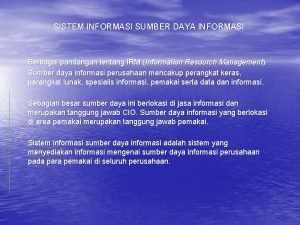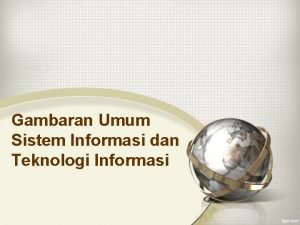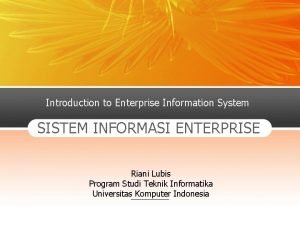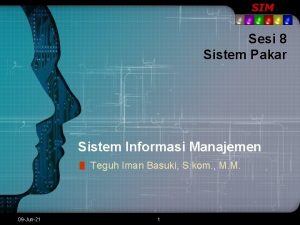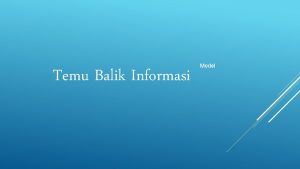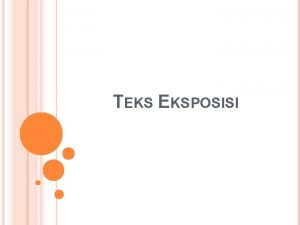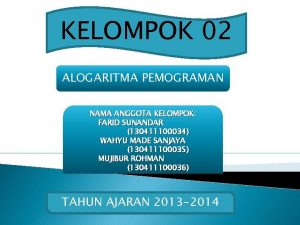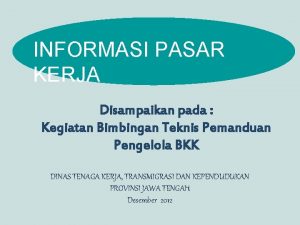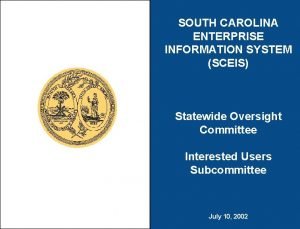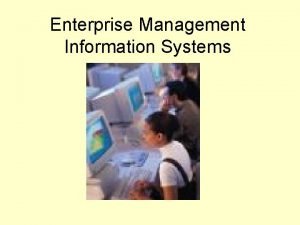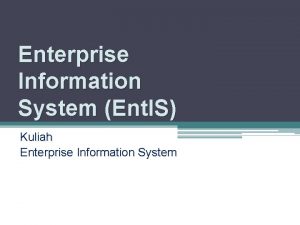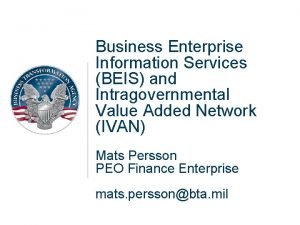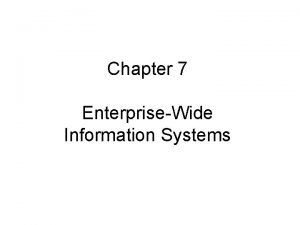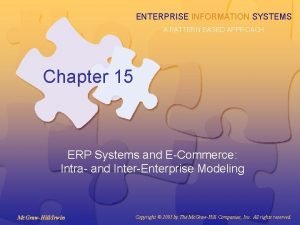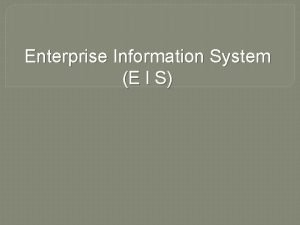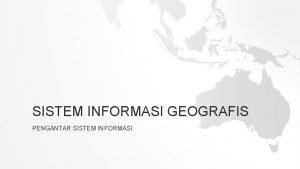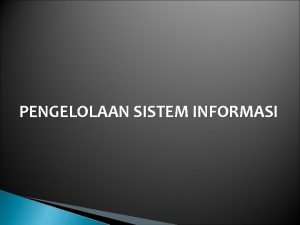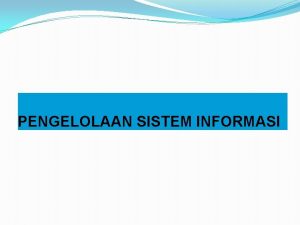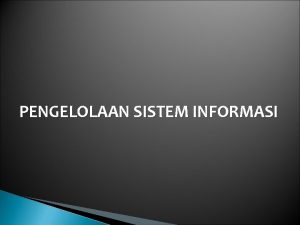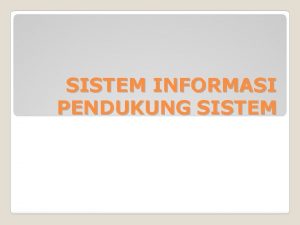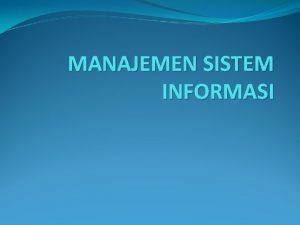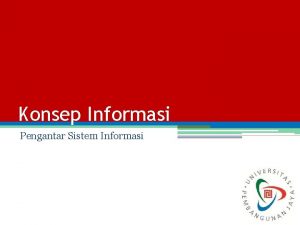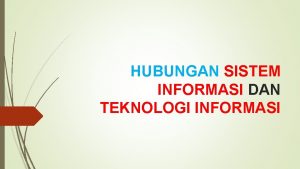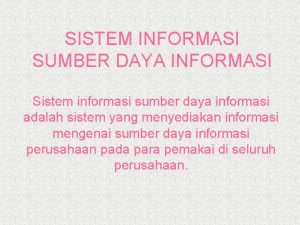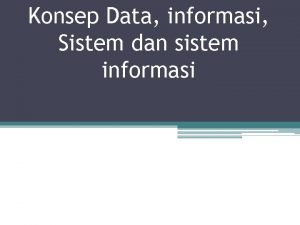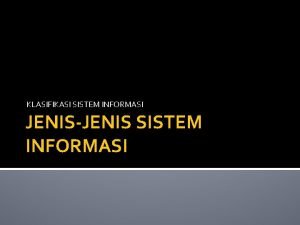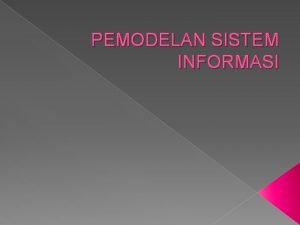Introduction to Enterprise Information System SISTEM INFORMASI ENTERPRISE
















- Slides: 16

Introduction to Enterprise Information System SISTEM INFORMASI ENTERPRISE Riani Lubis Program Studi Teknik Informatika Universitas Komputer Indonesia

Information System • An Information System is a work systems whose business process is devoted to capturing , transmitting, storing, retrieving, manipulating, and displaying information, thereby supporting other work systems (Alter, 2002). • An Information System can be defined technically as a set of interrelated components that collect (or retrieve), process, store, and distribute information to support decision making, coordination, and control in an organization (Laundon, 2001). • A Management Information System is an integrated usermachine system for providing information to support the operations, management, analysis, and decision-making functions in an organization (Davis, 1985). RNL - 2014 2

Organization & Information Systems • An organization is a stable, formal, social structure that takes resouces from the environment and processes them to produce outputs. • Information Systems must be aligned with the organization to provide information that important groups within the organization need. RNL - 2014 3

Kind of Information System RNL - 2014 4

Types of System in Enterprise RNL - 2014 5

Characteristics of Information Processing Systems Type of System Information Inputs Processing Information Outputs Users ESS Aggregate data; external; internal Graphics; simulations; interactive Projections; responses to queries Senior managers DSS Low-volume data or massive databases optimized for data analysis; analytic models & data analysis tools Interactive; simulations; analysis Special reports; decision analysis; responses to queries Professionals; staff managers MIS Summary transaction data; high-volume data; simple models Routine reports; simple models; lowlevel analysis Summary & exeptions reports Middle managers KWS Design specifications; knowledge base Modeling; simulations Models; graphics Professionals; technical staff Office Systems Documents; schedules Document management; scheduling; communication Documents; schedules; mail Clerical workers Transactions; events Sorting; listing; merging; updating Detailed reports; lists; summaries Operations personel; 6 supervisors TPS RNL - 2014

Transaction Processing Systems (Ex : A Payroll TPS) RNL - 2014 7

TPS Data for MIS Application RNL - 2014 8

A Sample of Decision Support System RNL - 2014 9

Model of a Typical Executive Support System RNL - 2014 10

Interrelationships Among Systems ESS MIS DSS KWS TPS OAS RNL - 2014 11

Enterprise Integration • Enterprise – A business, an industrious effort, especially one directed toward making money • Integrated – Joined together, united, made into a whole by having brought all parts together RNL - 2014 12

Aren’t all enterprise systems integrated ? NO! Why Not? Enterprise “stove pipes” or “silos” – As enterprises grow, they typically become divided based on functional areas – Each functional area typically has its own system – Even within functional areas, enterprises often develop different systems for different information needs • If existing systems lack functionality, additional systems are built to satisfy new needs RNL - 2014 13

Common Integration Attempts • Integrate the end results – Let each functional area have its own system and require them to submit end results in a standardized format that can be merged with results from other areas • Integrate similar types of systems – – All financial areas use same system All manufacturing areas use same system All areas associated with human resources use same system Etc…… • However, each of those systems are different from each other • Enterprise Systems – May be created from scratch – May be based on packaged software (e. g. Oracle. Apps, People. Soft, SAP) RNL - 2014 14

Enterprise System Manufacturing Accounting Business Processes Vendors Enterprise-wide Business Processes Human Resources Sales & RNL - 2014 Marketing Customers Finance 15

Common Integration Attempts RNL - 2014 16
 Sistem informasi sumber daya informasi
Sistem informasi sumber daya informasi Contoh gambaran umum sistem
Contoh gambaran umum sistem Contoh enterprise information system
Contoh enterprise information system Sistem pakar dalam sistem informasi manajemen
Sistem pakar dalam sistem informasi manajemen Putting the enterprise into the enterprise system
Putting the enterprise into the enterprise system Putting the enterprise into the enterprise system
Putting the enterprise into the enterprise system Judul dan nama anggota kelompok informasi gambar informasi
Judul dan nama anggota kelompok informasi gambar informasi Memaparkan atau menjelaskan informasi-informasi
Memaparkan atau menjelaskan informasi-informasi Judul dan nama anggota kelompok informasi gambar informasi
Judul dan nama anggota kelompok informasi gambar informasi Pengertian informasi pasar
Pengertian informasi pasar Sc enterprise information system
Sc enterprise information system Enterprise management information system
Enterprise management information system Mata raisyuu
Mata raisyuu Defense cash accountability system
Defense cash accountability system Enterprise wide information system
Enterprise wide information system Inter enterprise information system
Inter enterprise information system Karakteristik enterprise information system
Karakteristik enterprise information system
